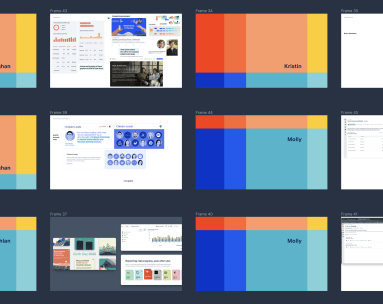
Watershed Design
Introduce us to your team
.jpg?_a=DATAdtfiZAA0)






What are your team rituals?
Our design team spans multiple time zones and disciplines, but stays close through a mix of weekly rituals, Slack and Zoom chats, and in-person gatherings.
-
Slack as our go-to spot to find each other
-
Each Monday, Open Mic: we share how we’re feeling & screenshots of our work from the past week (recent examples below!), then a topic brought to the group (e.g. designing for celebration states in the product, how to evolve the UX of form controls in our design system)


-
Tuesday & Thursday, Design Crit: we share in-progress work for feedback from other designers
-
In-person meetups and travel: In addition to whole-company offsites, design team members working together on a project often fly to work together in-person.
What does your team's product development process look like?
Our product development cycle at Watershed relies on small, agile pods working in lock step together on rapid iteration.
Each pod has a pretty traditional set up — a PM, a PD, and a handful of engineers. Bonus, each pod is also paired with a Climate Strategy Advisor + Carbon Data Analyst, who help us ensure we understand the user needs, problems, existing behaviors, data pipeline, etc.
We start each quarter with OKRs and a handful of prioritized projects. Designers are extremely involved in the process of identifying, sizing, and setting relative priority within their pod.
Once we kick off a project, designers work in rapid sprints to move from exploration to a flow that we have relative confidence in. These designs are brought to crit and shared within a pod as early as possible. After 1-2 weeks of discovery, eng will start to build the early designs to prepare for a usability test on production with a handful of users. From there, we'll iterate based on user feedback, and ship the feature to the hands of our users. We keep iterating from there. We try to timebox new features and products to 4-6 weeks from start to finish.
Should designers code?
If they want to! Though our entire design team uses tools including Figma, Figjam, & Notion, it’s “yes, and”—code is one of many valuable design tools. We believe in using the best tool for the job, and while Figma accelerates exploring many visual options, working directly with the CSS/React can be liberating for using production data (with all its edge cases) and dialing in live interactions.
For example, here’s a recent project where we jumped straight to code, since the real data & hover interaction defined much of the visual design:
Coding skills are not a requirement for joining the team, but any amount of technical skill is a plus!
What values does your team share?
Never delegate understanding.
Designers at Watershed do the work of thoroughly investigating the right problems to define the right solutions. We run our own research and testing, and ceaselessly iterate to adapt our tools to meet the needs of our users. We don’t make baseless decisions or assumptions. Our power is in actively seeking more knowledge and data on our customers, the climate and the business to make decisions with confidence.
Good judgement is the job.
Our work is filled with tradeoffs – balancing craft vs scrappiness, short-term vs long-term, current vs future customers, and more. There is no hiding from these tough decisions: the role of the designer is to look at these straight in the face and navigate through them.
Design is a team sport.
Designers at Watershed prioritize sharing early and often, collaboration and feedback throughout their design process. We can rely on each other’s expertise for support — whether it be for a product surface, a technical design skill, best practices or ideation — to level up our work and increase the efficacy of our decisions. While we believe the role of collaboration is essential to our team’s success, we are never blocked on unanimity.
Practice productive conflict.
Productive conflict and feedback are core to our design process, unlocking trust and growth within the team. We feel comfortable disagreeing with one another and cross-functional peers but do so with respect. We give and receive feedback graciously and with humility. In giving feedback, we inherently assume good intent. We treat each other and our work with dignity, kindness and compassion, enabling us to practice productive conflict.
Widen your lens.
We’re a stellar team because we welcome and learn from each other’s diverse opinions, skills, and backgrounds. We teach by doing and learn by observing one another. Designers feel safe to present big, bold and weird ideas in addition to sharp, specific and safe ideas. We approach each other’s ideas and opinions with a “yes, and” attitude.